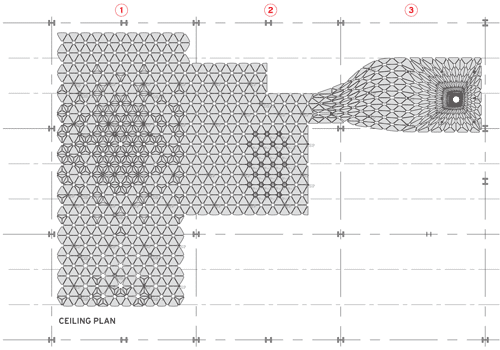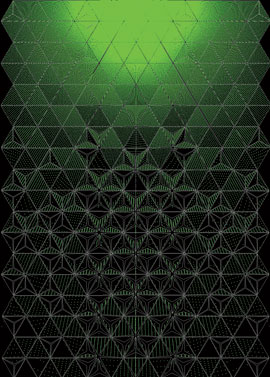When the Whole Is Greater Than the Sum of Its Parts
Acoustically wrapped structural beams, ductwork, and additional acoustical treatments, including sound-isolating posts and an acoustical blanket, are layered above and below the framing system, but well-hidden by the ceiling flowers. Assembly of the tornado was somewhat different, and relied on CNC milled plywood structural ribs that are hung by rods off the Unistrut system. "Many of the interiors we work on are 90 percent complete when we get them," Belzberg says. "So doing large, articulated surfaces requires us to get the sculpted effect outside the space."
Spectrum Oak in nearby Orange, California-the same shop that created Belzberg's design for the large, sculpted elements in the Patina Restaurant-milled the Conga Room's plywood panels. While the milling itself was completed within a week or two, installation of the panels took a little longer. "Once the installers started hanging the panels, there was another recalibration that took place," recalls Atwood.

|
||||
|
The club's layout is divided into three parts (above). The glowing, 20-foot-tall tornado penetrates the floor slab below it (bottom). Acoustical simulation programs were used to determine the ceiling�s porosity (left). Photo: © Benny Chan |
|||
 |
||||
Â
Installers suspended the ceiling panels in the main space according to a grid. As each row was hung from the Unistrut system, the architects would check that all of the various elements-panels, sprinkler heads, ductwork, framing-were coming together as planned. If something needed to be shifted, or an alteration of a panel was necessary, much of that could be done on-site.
For the uniquely shaped panels of the tornado, where tolerances were not as great as in the rest of the ceiling, alterations required an additional step. Atwood was able to make changes in the parametric model for a handful of tornado panels based on measurements taken on-site, immediately sending the modified information from his laptop to the fabricators so that they could produce new versions. "We input the information in the model, then e-mailed the Rhino file to the shop," explains Atwood. "The new panels were cut, painted, and delivered to the site the next morning. It worked surprisingly well, much better than anyone anticipated."










